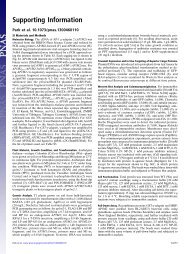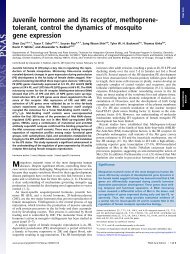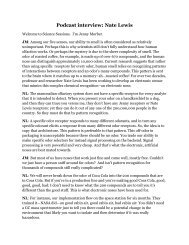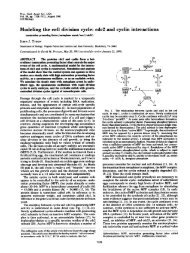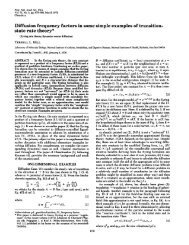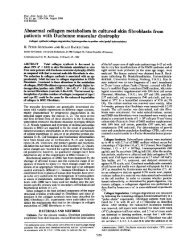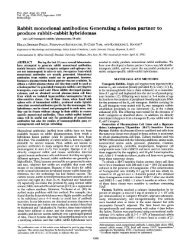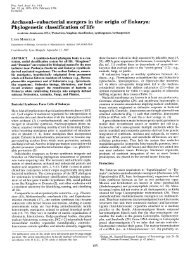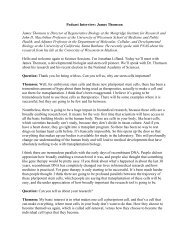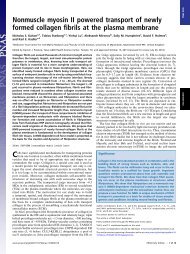SUMO-1 - Proceedings of the National Academy of Sciences
SUMO-1 - Proceedings of the National Academy of Sciences
SUMO-1 - Proceedings of the National Academy of Sciences
Create successful ePaper yourself
Turn your PDF publications into a flip-book with our unique Google optimized e-Paper software.
GFP-tagged <strong>SUMO</strong>-1, immunoprecipitations were performed<br />
with Flag antibody. Both anti-GFP and anti-<strong>SUMO</strong>-1 antibody<br />
detected <strong>the</strong> two slowly migrating bands <strong>of</strong> higher molecular<br />
mass in <strong>the</strong> immunoprecipitate, whereas <strong>the</strong> 115-kDa unmodified<br />
AR band was not detected (Fig. 1 B and C). When <strong>the</strong><br />
GFP-tagged <strong>SUMO</strong>-1G97A mutant, which cannot be conjugated<br />
to target proteins, was used instead <strong>of</strong> wild-type (wt)<br />
<strong>SUMO</strong>-1 (36), no sumoylated AR forms were found (Fig. 1,<br />
lanes 4 and 5). These results indicate that <strong>the</strong> slowly migrating<br />
bands represent <strong>SUMO</strong>-1-modified forms <strong>of</strong> AR and suggest<br />
that <strong>the</strong>re are at least two sumoylation sites in <strong>the</strong> receptor.<br />
Ligand treatment <strong>of</strong> COS-1 cells enhanced <strong>the</strong> <strong>SUMO</strong>-1<br />
modification <strong>of</strong> AR (Fig. 1, lanes 2 vs. 3). This is not explained<br />
by differences in <strong>the</strong> amount <strong>of</strong> AR protein in <strong>the</strong> cells (Fig. 1A).<br />
Ra<strong>the</strong>r, <strong>the</strong> role <strong>of</strong> <strong>the</strong> ligand is likely to be coupled to <strong>the</strong><br />
transfer <strong>of</strong> holo-AR to <strong>the</strong> nucleus, where Ubc9 is primarily<br />
located (U.K., unpublished work). Only a relatively small proportion<br />
<strong>of</strong> apo-AR resides in COS-1 cell nuclei, and ligand<br />
treatment induces a complete transfer <strong>of</strong> holo-AR to nuclei<br />
(37–39). The AR mutant �DBD, lacking most <strong>of</strong> <strong>the</strong> DBD and<br />
<strong>the</strong> flanking hinge region (amino acid residues 576–657), which<br />
contains <strong>the</strong> bipartite nuclear localization signal (37, 38), is<br />
transferred poorly to <strong>the</strong> nucleus on ligand exposure and is<br />
totally unable to recognize DNA (39). The �DBD mutant was<br />
sumoylated less efficiently than wt AR, although <strong>the</strong> pattern <strong>of</strong><br />
modification remained unchanged (Fig. 1A, lanes 6 and 7).<br />
Because <strong>the</strong> missing AR region is known to contribute to <strong>the</strong><br />
AR–Ubc9 interaction (9), <strong>the</strong> less efficient attachment <strong>of</strong><br />
<strong>SUMO</strong>-1 to <strong>the</strong> �DBD mutant could also derive from its<br />
inefficient interaction with Ubc9.<br />
K386 Is <strong>the</strong> Major AR Site Modified by <strong>SUMO</strong>-1. Sumoylation <strong>of</strong><br />
proteins has been shown to occur at specific Lys residues,<br />
which are in most cases embedded in a consensus sequence<br />
(I�L�V)KXE, where X represents any amino acid (40, 41).<br />
Expression <strong>of</strong> a series <strong>of</strong> AR deletion mutants in COS-1 cells<br />
indicated that <strong>the</strong> two major slowly migrating forms <strong>of</strong> AR<br />
depended on <strong>the</strong> presence <strong>of</strong> <strong>the</strong> region encompassing amino<br />
acids 337–553 in <strong>the</strong> N-terminal region (data not shown). This<br />
region contains three Lys residues, K347, K386, and K520. Of<br />
<strong>the</strong>se three residues, <strong>the</strong> neighboring amino acid residues <strong>of</strong><br />
K386 (sequence IKLE) and K520 (sequence VKSE) match with<br />
<strong>the</strong> proposed <strong>SUMO</strong>-1 attachment consensus sequence. To test<br />
whe<strong>the</strong>r <strong>the</strong>se residues were indeed sumoylated, point mutations<br />
K386R and K520R were introduced into <strong>the</strong> Flag-tagged human<br />
AR. Immunoprecipitations <strong>of</strong> AR from extracts <strong>of</strong> COS-1 cells<br />
expressing <strong>the</strong>se constructs revealed that <strong>the</strong> K386R mutant <strong>of</strong><br />
AR is only weakly sumoylated (Fig. 2A, lane 4). Even though <strong>the</strong><br />
K520R mutation was not as deleterious to <strong>the</strong> modification as<br />
<strong>the</strong> K386R mutation, <strong>the</strong> K520R mutant <strong>of</strong> AR was never<strong>the</strong>less<br />
less efficiently sumoylated than wt AR (Fig. 2A, lane 5). When<br />
<strong>the</strong> point mutations were combined, no <strong>SUMO</strong>-1 was attached<br />
to <strong>the</strong> double mutant (Fig. 2A, lane 6). Likewise, in <strong>the</strong> absence<br />
<strong>of</strong> ectopically expressed <strong>SUMO</strong>-1, immunoblotting revealed<br />
slower migrating AR forms in cells expressing <strong>the</strong> wt AR but not<br />
in those expressing <strong>the</strong> compound mutant (Fig. 2B Upper).<br />
Immunoblotting <strong>of</strong> immunoprecipitated ARs with anti-<strong>SUMO</strong>-1<br />
antibody confirmed that <strong>the</strong> slower migrating AR forms indeed<br />
represented sumoylated AR (Fig. 2B Lower).<br />
Ubc9 Catalyzes Sumoylation <strong>of</strong> AR in Vitro. To study <strong>the</strong> catalytic<br />
role <strong>of</strong> Ubc9 in <strong>SUMO</strong>-1 modification <strong>of</strong> AR, 35 S-Met-labeled<br />
AR was incubated in <strong>the</strong> absence and presence <strong>of</strong> GST-Ubc9<br />
with GST-<strong>SUMO</strong>-1 and a HeLa cell fraction containing <strong>SUMO</strong>-<br />
1-activating enzyme (15). Ubc9 was required to produce <strong>the</strong> two<br />
slowly migrating forms <strong>of</strong> AR, corresponding to <strong>the</strong> AR<br />
<strong>SUMO</strong>-1 conjugates (Fig. 3A, lanes 1 and 2). This pattern is in<br />
line with <strong>the</strong> sumoylated AR forms detected with GFP-<strong>SUMO</strong>-1<br />
Fig. 2. K386 is <strong>the</strong> major sumoylation site in AR. COS-1 cells were transfected<br />
with pGFP-<strong>SUMO</strong>-1 or empty expression vector as indicated along with wt<br />
Flag-hAR, Flag-K386R, Flag-K520R, or Flag-K386R�K520R. The cells received<br />
100 nM testosterone 12 h before harvesting. Immunoblots and immunoprecipitations<br />
were performed as described in Fig. 1. (A Upper) Immunoblotting<br />
(WB) <strong>of</strong> cell extracts with anti-AR antibody (�-AR); (A Lower) immunoprecipitation<br />
with anti-Flag antibody and subsequent immunoblotting with anti-GFP<br />
antibody (�-GFP). (B Upper) COS-1 cells were transfected with expression<br />
vectors encoding wt AR or <strong>the</strong> K386R�K520R mutant, and <strong>the</strong> cell extracts<br />
were analyzed by immunoblotting with anti-AR antibody (�-AR); (B Lower)<br />
immunoprecipitation with anti-Flag antibody and subsequent immunoblotting<br />
with anti-<strong>SUMO</strong>-1 antibody (�-<strong>SUMO</strong>). Arrowheads depict <strong>the</strong> slowly<br />
migrating <strong>SUMO</strong>-1-conjugated ARs.<br />
by immunoblotting with anti-AR antibody (Fig. 2A Upper),<br />
because <strong>the</strong> size <strong>of</strong> GST-<strong>SUMO</strong>-1 is comparable to that <strong>of</strong><br />
GFP-<strong>SUMO</strong>-1. If <strong>the</strong> HeLa cell fraction or GST-<strong>SUMO</strong>-1 was<br />
omitted from <strong>the</strong> reaction, <strong>the</strong> slowly migrating AR bands were<br />
not detectable (data not shown). With <strong>the</strong> K386R mutant <strong>of</strong> AR,<br />
only a single very weak additional band was obtained in <strong>the</strong><br />
presence <strong>of</strong> Ubc9 (Fig. 3A, lane 3). The incubation <strong>of</strong> K520R<br />
mutant with Ubc9 yielded also only one additional major band,<br />
Fig. 3. Ubc9 catalyzes attachment <strong>of</strong> <strong>SUMO</strong>-1 to AR and GR in vitro. (A) In<br />
vitro-translated 35 S-Met-labeled wt and mutated AR constructs were incubated<br />
with GST-<strong>SUMO</strong>-1 and HeLa cell fraction containing <strong>SUMO</strong>-1-activating enzyme<br />
in <strong>the</strong> presence (�) or absence (�) <strong>of</strong> GST-Ubc9. The samples were resolved on<br />
7.5% SDS�PAGE and subjected to fluorography. Arrowheads depict <strong>the</strong> slowly<br />
migrating sumoylated forms <strong>of</strong> AR; Star, unmodified AR. (B) In vitro <strong>SUMO</strong>-1<br />
conjugation reactions with GR, ER�,ER�, and TR�. The reactions were performed<br />
in <strong>the</strong> presence (�) or absence (�) <strong>of</strong> GST-Ubc9 as described in A.<br />
Poukka et al. PNAS � December 19, 2000 � vol. 97 � no. 26 � 14147<br />
BIOCHEMISTRY



